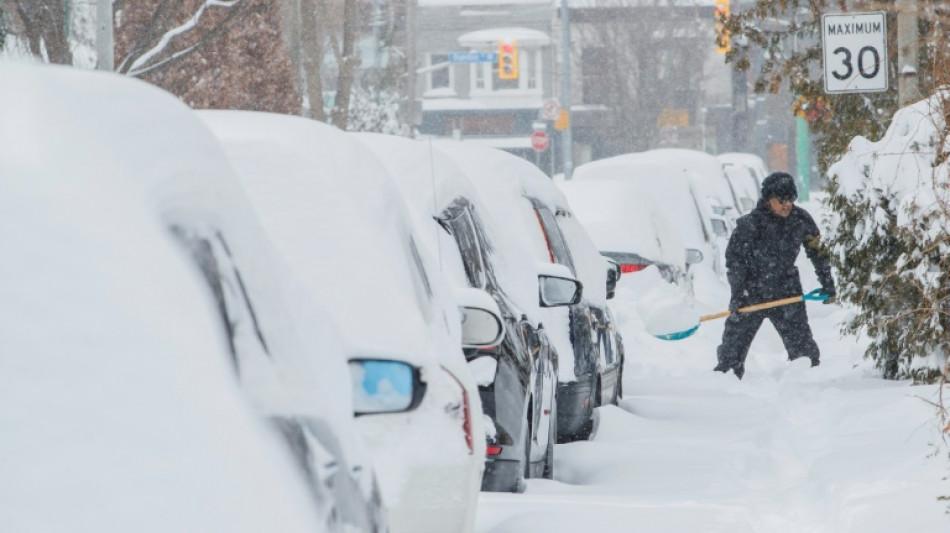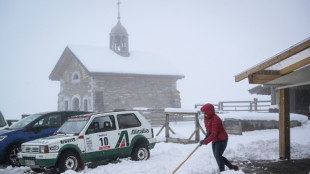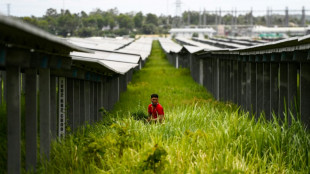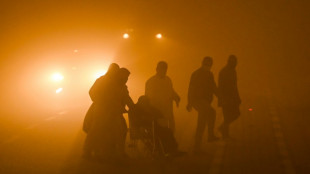
| GSK | 0.46% | 36.095 | $ | |
| CMSC | -0.6% | 21.69 | $ | |
| BTI | 0.43% | 42.555 | $ | |
| CMSD | -0.92% | 21.76 | $ | |
| RIO | -0.12% | 58.1 | $ | |
| BP | -1.94% | 27.78 | $ | |
| NGG | 0.55% | 72.511 | $ | |
| BCC | -2.42% | 91.262 | $ | |
| AZN | -0.21% | 67.45 | $ | |
| RBGPF | 0% | 63.45 | $ | |
| SCS | -2.85% | 9.49 | $ | |
| RYCEF | -0.96% | 9.41 | $ | |
| JRI | -0.4% | 12.35 | $ | |
| RELX | 0.25% | 52.33 | $ | |
| BCE | 0.52% | 22.155 | $ | |
| VOD | -0.38% | 9.275 | $ |

Travel woes as winter storm blankets eastern US and Canada
A major winter storm blanketed a swath of North America in snow stretching up the east coast from Georgia to Canada, disrupting travel and cutting power to thousands of homes.
The Canadian capital Ottawa, which was under a blizzard warning Monday, saw nearly 19 inches (48 centimeters) of snow, Environment Canada said.
Ottawa paramedics thanked an eight-year-old boy for helping save an elderly man he found nearly buried in snow on Monday.
"The gentleman was almost all covered due to the huge snowfall when Clayton spotted him & notified his parents who activated 9-1-1," the paramedic service tweeted with a photo of the boy.
Across the border, the Ohio city of Ashtabula, on the shores of Lake Erie, saw 27 inches of snow, while down south even parts of Georgia and South Carolina received about 10 inches, the US National Weather Service tweeted.
There was relief however for many Americans who had been without electricity as supplies were gradually restored, with fewer than 40,000 customers still without power early Tuesday, compared with about 120,000 Monday afternoon, according to the website PowerOutage.us.
More than 1,700 flights within, into or out of the United States were canceled Monday, in addition to 3,000 the day before, according to flight-tracking website FlightAware.
With the storm conditions abating, just 175 flights were canceled on Tuesday.
As snow accumulation slowed by late Monday, blizzard and winter storm warnings for much of the Canadian province of Ontario were lifted, although snow squall and extreme cold warnings remained in place.
Toronto, which saw nearly a foot (29 centimeters) of snow, and Ottawa banned cars from parking on the streets under winter rules to allow snow plows to clear the cities.
Many schools were closed and school buses were not operating in Quebec and the south of Ontario, including the Toronto area. Students had been due to return to classrooms on Monday in both provinces after the holiday break.
- 'Stay home!' -
Monday was a national holiday in the United States, so most schools and businesses were already closed, though many people usually take the opportunity to travel during the long weekend.
The National Weather Service said earlier it expected the storm to "slowly wind down" but that snow would continue to fall through the evening in upper New York and New England.
"Significant impacts due to snow, ice, wind, and coastal flooding will persist across a large area," the NWS said in a tweet.
The storm spawned damaging tornadoes in Florida, while in the Carolinas and up through the Appalachian mountain region, icy conditions and blustery winds raised concerns.
Powerful winds downed trees and caused coastal flooding, with a 12-foot storm surge reported in Boston.
According to scientists, climate change could be an aggravating factor for extreme weather events such as snowstorms, as well as deadly floods, typhoons and heat waves.
Transport was also seriously disrupted, with drivers warned of hazardous road conditions and major travel headaches from the southern US state of Arkansas to Quebec.
In Toronto, police tweeted that they had closed two sections of highway due to extreme weather, and asked drivers to stay home, "unless it's absolutely necessary."
"We're seeing a number of cars having to stop and de-ice their windshield," the Quebec transportation ministry tweeted Monday morning.
"Heavy precipitation and gusts allow ice to form, despite windshield wipers -- all the more reason to stay home!"
US officials also discouraged driving, and many states prepositioned teams to deal with the emergency, especially in the south, where snow is much less common.
The northeastern United States already experienced snow chaos earlier this month. When a storm blanketed the northeast, hundreds of motorists were stuck for more than 24 hours on the I-95, a major highway linking to Washington.
S.Vandenberghe--JdB



